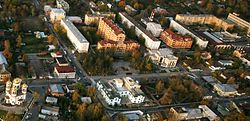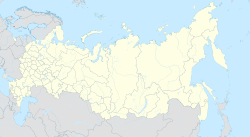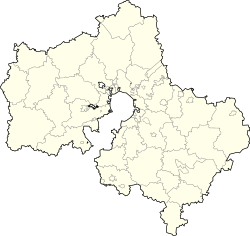world.wikisort.org - Russia
Zvenigorod (Russian: Звени́город) is an old town in Moscow Oblast, Russia. Population: 16,395 (2010 Census);[2] 12,155 (2002 Census);[7] 15,805 (1989 Census).[8]
Zvenigorod
Звенигород | |
|---|---|
Town[1] | |
 | |
 Flag  Coat of arms | |
Location of Zvenigorod  | |
 Zvenigorod Location of Zvenigorod  Zvenigorod Zvenigorod (Moscow Oblast) | |
| Coordinates: 55°44′N 36°51′E | |
| Country | Russia |
| Federal subject | Moscow Oblast[1] |
| First mentioned | 1338 |
| Town status since | 1784 |
| Area | |
| • Total | 48.1 km2 (18.6 sq mi) |
| Elevation | 150 m (490 ft) |
| Population | |
| • Total | 16,395 |
| • Estimate (2018)[3] | 22,513 (+37.3%) |
| • Density | 340/km2 (880/sq mi) |
Administrative status | |
| • Subordinated to | Zvenigorod Town Under Oblast Jurisdiction[1] |
| • Capital of | Zvenigorod Town Under Oblast Jurisdiction[1] |
Municipal status | |
| • Urban okrug | Zvenigorod Urban Okrug[4] |
| • Capital of | Zvenigorod Urban Okrug[4] |
| Time zone | UTC+3 (MSK |
| Postal code(s)[6] | |
| Dialing code(s) | +7 49869 |
| OKTMO ID | 46730000001 |
History

The town's name is based either on a personal name (cf. Zvenislav, Zvenimir) or on a hydronym (cf. the Zvinech, Zvinyaka, Zveniga Rivers); the derivation from "town of ringing (bells)" is a folk etymology.[9]
The community has existed since the 12th century, although its first written mention is dated around 1339, in the last will of Grand Duke of Moscow Ivan I Daniilovich Kalita, in which he says: "Thus, I pass on to my son Ivan: Zvenigorod, Kremchina, Ruza..."[10][11] In the historical records, or annals (лéтопись [letopis'] in Russian), Zvenigorod is first mentioned around 1382, soon after khan Tokhtamysh burnt down Moscow, and destroyed a number of towns on the way, including Zvenigorod.[12][13]
Zvenigorod rose to prominence in the late 14th century after it was bequeathed by Dmitry Donskoy to his second son Yuri, who founded his residence on the steep bank of the Moskva River. The local kremlin, called Gorodok, contains the only fully preserved example of 14th-century Muscovite architecture, the Dormition Cathedral (1399). The cathedral's interior features frescoes attributed to Andrei Rublev.
Zvenigorod is primarily remembered for internecine wars waged by Yuri's sons for control of Moscow during the reign of their cousin Vasily II (1425–1462). After their party was defeated, the town was incorporated into the Grand Duchy of Moscow.
Zvenigorod was granted town rights in 1784.[citation needed] By the late 19th century, the town gained popularity among the intelligentsia as a fashionable banlieue of Moscow. Many extravagant dachas were built in the neighbourhood. Some of these house museums of Sergey Taneyev, Anton Chekhov, and Isaac Levitan.
During World War II Zvenigorod was near, or on the frontline in the 1941-2 Battle of Moscow.
Savvino-Storozhevsky Monastery

The Storozhi Monastery near Zvenigorod was established in 1398 by St. Savva, one of the first disciples of Sergius of Radonezh. The oldest church is the katholikon completed in 1405 and dedicated to the feast of the Nativity of the Theotokos. In 1650, the monastery was chosen by Tsar Alexis as his suburban residence. In five years, they constructed a white-stone royal palace and a festive chamber for tsaritsa. The compound was encircled with stone walls and towers, patterned after those of the Trinity Lavra of St. Sergius. Particularly noteworthy is a large belfry, erected in four bays in 1650 and crowned with three tents and a clocktower. A church over the holy gates was consecrated to the Holy Trinity in 1652.[14]
After the death of Feodor III, who spent most of his time there, the monastery declined. In May 1918, when the Bolsheviks tried to seize the relics of St. Savva, several persons were shot dead. In 1985, the cloister was assigned to the Danilov Monastery in Moscow. St. Savva's relics were returned to the monastery in 1998.
Administrative and municipal status
Within the framework of administrative divisions, it is incorporated as Zvenigorod Town Under Oblast Jurisdiction—an administrative unit with the status equal to that of the districts.[1] As a municipal division, Zvenigorod Town Under Oblast Jurisdiction is incorporated as Zvenigorod Urban Okrug.[4]
Sport
The city has a woman's handball team Zvezda Zvenigorod, which won the Women's EHF Champions League in the 2007–08 season.
International relations
Twin towns — Sister cities
Zvenigorod is twinned with:
References
Notes
- Law #11/2013-OZ
- Russian Federal State Statistics Service (2011). Всероссийская перепись населения 2010 года. Том 1 [2010 All-Russian Population Census, vol. 1]. Всероссийская перепись населения 2010 года [2010 All-Russia Population Census] (in Russian). Federal State Statistics Service.
- http://www.gks.ru/free_doc/doc_2018/bul_dr/mun_obr2018.rar; archive date: 26 July 2018; retrieved: 25 July 2018; archive URL: https://web.archive.org/web/20180726010024/http://www.gks.ru/free_doc/doc_2018/bul_dr/mun_obr2018.rar.
- Law #36/2005-OZ
- "Об исчислении времени". Официальный интернет-портал правовой информации (in Russian). June 3, 2011. Retrieved January 19, 2019.
- Почта России. Информационно-вычислительный центр ОАСУ РПО. (Russian Post). Поиск объектов почтовой связи (Postal Objects Search) (in Russian)
- Russian Federal State Statistics Service (May 21, 2004). Численность населения России, субъектов Российской Федерации в составе федеральных округов, районов, городских поселений, сельских населённых пунктов – районных центров и сельских населённых пунктов с населением 3 тысячи и более человек [Population of Russia, Its Federal Districts, Federal Subjects, Districts, Urban Localities, Rural Localities—Administrative Centers, and Rural Localities with Population of Over 3,000] (XLS). Всероссийская перепись населения 2002 года [All-Russia Population Census of 2002] (in Russian).
- Всесоюзная перепись населения 1989 г. Численность наличного населения союзных и автономных республик, автономных областей и округов, краёв, областей, районов, городских поселений и сёл-райцентров [All Union Population Census of 1989: Present Population of Union and Autonomous Republics, Autonomous Oblasts and Okrugs, Krais, Oblasts, Districts, Urban Settlements, and Villages Serving as District Administrative Centers]. Всесоюзная перепись населения 1989 года [All-Union Population Census of 1989] (in Russian). Институт демографии Национального исследовательского университета: Высшая школа экономики [Institute of Demography at the National Research University: Higher School of Economics]. 1989 – via Demoscope Weekly.
- Е. М. Поспелов. Географические названия мира (Москва: Русские словари, 1998), p. 160.
- "Великое княжество Московское и княжества северо-восточной Руси | Виртуальная выставка к 1150-летию зарождения российской государственности". rusarchives.ru. Archived from the original on August 5, 2017. Retrieved July 17, 2018.
- "Иван Калита". www.hrono.info. Retrieved July 17, 2018.
- Историческая справка - Городской округ Звенигород. www.zvenigorod.ru (in Russian). Retrieved July 17, 2018.
- Korolev, N. (May 29, 2014). "A day trip to Zvenigorod". Russia Beyond the Headlines. Retrieved January 29, 2020.
- Kamalakaran, A. (July 29, 2016). "4 Orthodox monasteries to visit near Moscow". Russia Beyond the Headlines. Retrieved January 29, 2020.
- "Bijie and Zvenigorod are sister cities!". Териториальное управление Звенигород (in Russian). August 16, 2016.
Sources
- Московская областная Дума. Закон №11/2013-ОЗ от 31 января 2013 г. «Об административно-территориальном устройстве Московской области», в ред. Закона №249/2019-ОЗ от 29 ноября 2019 г. «О внесении изменений в Закон Московской области "Об административно-территориальном устройстве Московской области"». Вступил в силу на следующий день после официального опубликования (13 января 2013 г.). Опубликован: "Ежедневные Новости. Подмосковье", №24, 12 февраля 2013 г. (Moscow Oblast Duma. Law #11/2013-OZ of January 31, 2013 On the Administrative-Territorial Structure of Moscow Oblast, as amended by the Law #249/2019-OZ of November 29, 2019 On amending the Law of Moscow Oblast "On the Administrative-Territorial Structure of Moscow Oblast". Effective as of the day following the day of the official publication (January 13, 2013).).
- Московская областная Дума. Закон №36/2005-ОЗ от 3 февраля 2005 г. «О статусе и границе городского округа Звенигорд», в ред. Закона №12/2010-ОЗ от 26 февраля 2010 г «О внесении изменений в Закон Московской области "О статусе и границе городского округа Звенигород" и Закон Московской области "О статусе и границах Одинцовского муниципального района и вновь образованных в его составе муниципальных образований"». Вступил в силу со дня официального опубликования. Опубликован: "Ежедневные Новости. Подмосковье", №26, 12 февраля 2005 г. (Moscow Oblast Duma. Law #36/2005-OZ of February 3, 2005 On the Status and the Border of Zvenigorod Urban Okrug, as amended by the Law #12/2010-OZ of February 26, 2010 On Amending the Law of Moscow Oblast "On the Status and the Border of Zvenigorod Urban Okrug" and the Law of Moscow Oblast "On the Status and the Borders of Odintsovsky Municipal District and the Newly Established Municipal Formations It Comprises". Effective as of the day of the official publication.).
External links
![]() Media related to Zvenigorod at Wikimedia Commons
Media related to Zvenigorod at Wikimedia Commons
- Official website of Zvenigorod (in Russian)
- Zvenigorod Business Directory (in Russian)
- About St. Savva Storozevsky and Zvenigorod in the book in a series "Life of outstanding people" by K. Kovalev
На других языках
[de] Swenigorod
Swenigorod (russisch Звени́город; Aussprache?/i) ist eine russische Kleinstadt in der Oblast Moskau, rund 50 km westlich von Moskau entfernt. Die 16.395 Einwohner (Stand 14. Oktober 2010)[1] zählende Stadt liegt an den Smolensker Höhen am Oberlauf der Moskwa und gehört zu den ältesten Orten im Moskauer Umland.- [en] Zvenigorod
[ru] Звенигород
Звени́город — город (с 1781) в Московской области России. Население — 35 842[1] чел. (2021).Другой контент может иметь иную лицензию. Перед использованием материалов сайта WikiSort.org внимательно изучите правила лицензирования конкретных элементов наполнения сайта.
WikiSort.org - проект по пересортировке и дополнению контента Википедии
